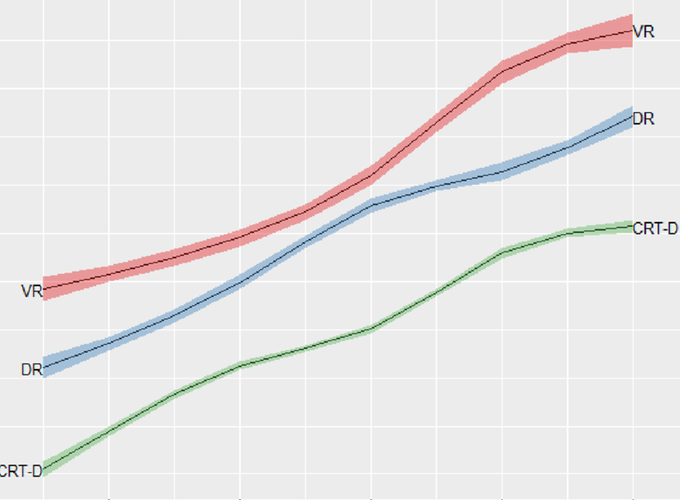Favorable Trend of Implantable Cardioverter-Defibrillator Service Life in a Large Single-Nation Population: Insights From 10-Year Analysis of the Italian Implantable Cardioverter-Defibrillator Registry
 Model fitted by implantable cardioverter‐defibrillator (ICD) type: trend of the expected service life (in months) as modeled by the years. Vertical bars represent the original data. Shadows represent the 95% CI for the drawn lines. CRT‐D indicates cardiac resynchronization therapy defibrillator; DR, dual‐chamber device; VR, single‐chamber device.
Model fitted by implantable cardioverter‐defibrillator (ICD) type: trend of the expected service life (in months) as modeled by the years. Vertical bars represent the original data. Shadows represent the 95% CI for the drawn lines. CRT‐D indicates cardiac resynchronization therapy defibrillator; DR, dual‐chamber device; VR, single‐chamber device.
Favorable Trend of Implantable Cardioverter-Defibrillator Service Life in a Large Single-Nation Population: Insights From 10-Year Analysis of the Italian Implantable Cardioverter-Defibrillator Registry
Abstract
Background Implantable cardioverter‐defibrillators (ICDs) are widely employed for the prevention of sudden cardiac death. Despite technological improvements, patients often need to undergo generator replacement, which entails the risk of periprocedural complications. Our aim was to estimate the service life of ICDs over a 10‐year interval and to assess the main causes of replacement on the basis of data from the National ICD Registry of the Italian Society of Arrhythmology and Cardiac Pacing (AIAC). Methods and Results The registry includes data from over 400 hospitals in Italy. We included all patients who underwent device replacement from calendar years 2007 to 2016. The median service life of the ICDs and its trend over the years was estimated across the 3 types of devices (single‐chamber, dual‐chamber, cardiac resynchronization therapy defibrillator) and the indication to implantation. The causes of replacement were also analyzed. We included 29 158 records from 27 676 patients (80.9% men; mean age at device replacement 65.8±12.0 years). The median service life was 57.3 months (interquartile range 27.8 months). Over the years, service life showed an increasing trend. The majority of patients underwent elective replacement because of battery end of life, and over the years there was a significant reduction of replacement for recalls, erosion/infections, and cardiac resynchronization therapy upgrading. Conclusions Our data from a large single‐nation population showed that the trend of ICD service life, independently from ICD type, indication, and settings, significantly improved over time. Moreover, there was a striking reduction of interventions for upgrading and infection/erosion. This favorable trend has important clinical, organizational, and financial implications.